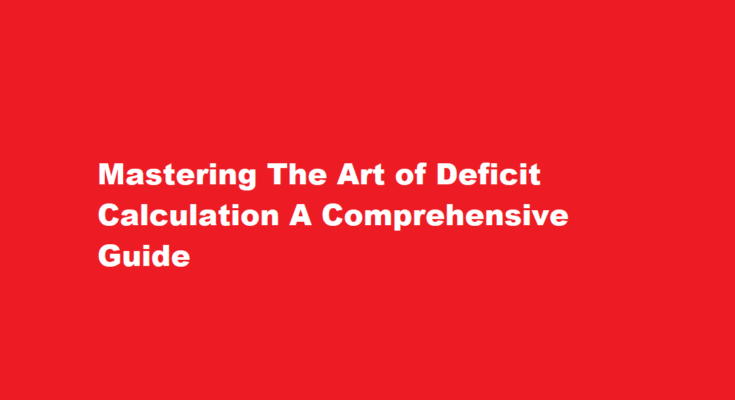Introduction
Deficit calculation is a fundamental concept in economics and finance that plays a crucial role in understanding the financial health of individuals, businesses, and governments. Whether you’re managing personal finances, evaluating a company’s performance, or analyzing a nation’s economic standing, knowing how to accurately calculate a deficit is essential. In this article, we’ll delve into the intricacies of deficit calculation, providing you with a clear and comprehensive guide.
Defining Deficit
A deficit occurs when expenditures exceed revenues within a specified period. This can apply to personal budgets, corporate finances, or government accounts. Understanding the types of deficits is vital. A budget deficit arises when expenses surpass income in a specific timeframe, while a trade deficit occurs when a nation’s imports exceed its exports. Similarly, a fiscal deficit pertains to a government’s total expenditures surpassing its total revenue collection.
Steps to Calculate a Deficit
1. Gather Financial Data – Begin by collecting all relevant financial information, including income sources, expenses, trade data, or government revenues and expenditures.
2. Identify Income and Revenue – For personal finance, sum up all your earnings – salaries, investments, and other sources. In a business context, consider sales, investments, and interest income. In the case of a government, it’s tax revenue, grants, and other income streams.
3. Sum Up Expenditures – Calculate all expenses – from personal spending, business operations, to government programs. These can include salaries, operational costs, and infrastructure development.
4. Analyze Trade Data – For a trade deficit, subtract the value of exports from imports. A positive value indicates a trade surplus, while a negative value signifies a trade deficit.
5. Calculate the Deficit – Subtract total expenses from total income. For a budget deficit, subtract total expenses from total income. In trade and fiscal deficits, subtract total imports or total government expenditures from total exports or total government revenues, respectively.
Understanding Implications
A deficit isn’t inherently negative; it’s the context that matters. A personal budget deficit might indicate overspending, urging you to reevaluate expenses. In business, a deficit might result from heavy investments, potentially leading to future gains. Governments may run deficits to stimulate economic growth. However, persistent deficits, especially fiscal ones, can lead to accumulated debt, inflation, and reduced economic stability.
Interpreting the Numbers
The calculated deficit number alone might not provide a complete picture. To gain deeper insights
Relative Values: Compare the deficit to income or GDP for context.
Trends:Analyze how deficits change over time. Are they increasing, decreasing, or fluctuating?
Structural vs. Cyclical Deficits: Distinguish between deficits caused by economic cycles and those reflecting long-term imbalances.
Addressing Deficits
1. Personal Finance – Cut discretionary expenses, create a budget, and increase income sources.
2. Business –Adjust pricing, optimize operations, and diversify income streams.
3. Government – Enhance revenue collection through taxation or economic growth, reduce unnecessary expenditures, and prioritize critical investments.
Frequently Asked Questions
How do you calculate what your deficit should be?
To perform a manual calculation, moderately active people can multiply their current body weight by 15 to estimate how many calories they would need each day. Then, to determine how many calories they should consume for a healthful calorie deficit, they can subtract roughly 500 calories from that number.
What is RMR and BMR?
Basal metabolic rate (BMR) and resting metabolic rate (RMR) both measure the amount of energy —in calories —that your body needs to stay alive and function properly. Many people use the two terms interchangeably, but they have slightly different meanings.
Conclusion
In a world driven by economic dynamics, deficit calculation serves as a compass guiding financial decisions. By mastering deficit calculation techniques and understanding their implications, individuals, businesses, and governments can navigate toward more informed and sustainable financial futures. Remember, deficits are more than numbers; they convey stories of financial health and provide directions for economic progress.
Read Also : Managing a Rapid Heartbeat Tips for Restoring a Healthy Rhythm



